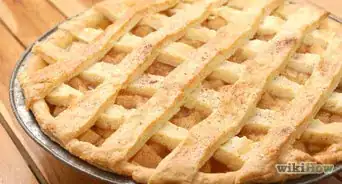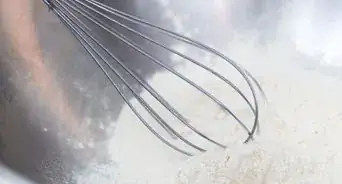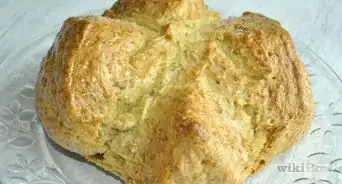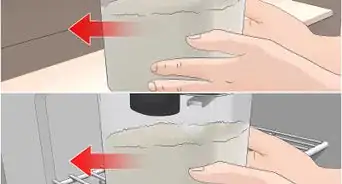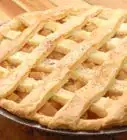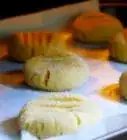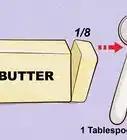wikiHow is a “wiki,” similar to Wikipedia, which means that many of our articles are co-written by multiple authors. To create this article, 29 people, some anonymous, worked to edit and improve it over time.
There are 7 references cited in this article, which can be found at the bottom of the page.
wikiHow marks an article as reader-approved once it receives enough positive feedback. In this case, 93% of readers who voted found the article helpful, earning it our reader-approved status.
This article has been viewed 583,326 times.
Learn more...
Blind baking is partially or completely baking a pastry base before adding the filling. This creates a stronger crust that can hold moist filling without getting soggy; it's also useful when filling needs less time to cook than the pastry. If you want to learn to blind bake, see Step 1 to get started today.
Steps
-
1Select your pie dish. Tin or glass pie dishes are most common.
-
2Place your freshly prepared pastry in the pie dish according to the recipe's instructions. To achieve a snug fit, gently drop the pie dish onto the kitchen bench a few times to help the pastry settle into the edges.[1]Advertisement
-
3Chill the pastry base for half an hour in the freezer to firm it. Cover the dish with a clean tea towel or greaseproof paper. This firming assists in stopping the pastry from shrinking during baking.[2]
-
4Dock the dough by piercing the base with a fork in several places to allow airflow and prevent bubbles. Don't overdo it, though; too many holes will let the filling leak through the crust.[3]
-
5Place one of the following over the pastry base, cutting the covering wide enough to make sure it covers the edges as well:[4]
- Baking paper (parchment) or greaseproof (wax) paper TIP: 'Scrunch' the paper up a few times before using – this makes it more pliable and able to mold into the bottom angle (and sides of a fluted tin).
- Coffee filter (unbleached)
- Aluminum foil (vented tent) -- make a "breathing" crust shield)
-
6Place dried beans, dry rice, dry lentils or pie weights on top of the covering. This prevents the pastry base from rising through air bubbles, which would leave it uneven and weakened. For easier clean-up, place the beans in an oven bag or a cheesecloth satchel tied with kitchen twine.[5]
-
7Place the pie dish in an oven at the temperature and for the length of time suggested by the recipe. If there is no suggested temperature, or you are making this up as you go, heat the oven to medium heat (approx. 200ºC/400ºF) and bake the base for approximately 15 minutes, (less for a pastry containing sugar). Keep an eye on its progress; the key colour to watch for is a light golden brown.[6]
-
8Remove the dish from the oven and allow the pastry to cool for 3-5 minutes. At this stage, some chefs apply an egg wash to the crust to prevent it from absorbing moisture from the filling. To do this, cook the pastry for a little less time in Step 7. Pop the glazed base back into the oven for a 2-minute bake to set the egg wash. Remove once again and allow 1 minute for cooling before adding the filling.
-
9Add filling and bake the pie for the time recommended by your recipe. If you are not following a recipe, reduce the heat for the last baking (180ºC/350ºF). Because the base and edges are baked by now, the pastry will continue to brown while you leave the whole pie in the oven. To allay this, make sure the filling will bake quickly (sometimes you will need to precook it to get the baking time down enough) and cover the edges of the pastry with a foil ring.
-
10Finished.
Community Q&A
Did you know you can get answers researched by wikiHow Staff?
Unlock staff-researched answers by supporting wikiHow
-
QuestionCan I reuse beans used for blind baking?
 wikiHow Staff EditorThis answer was written by one of our trained team of researchers who validated it for accuracy and comprehensiveness.
wikiHow Staff EditorThis answer was written by one of our trained team of researchers who validated it for accuracy and comprehensiveness.
Staff Answer wikiHow Staff EditorStaff Answer
wikiHow Staff EditorStaff Answer -
QuestionIs it possible to make a blind baked pastry base ahead?
 wikiHow Staff EditorThis answer was written by one of our trained team of researchers who validated it for accuracy and comprehensiveness.
wikiHow Staff EditorThis answer was written by one of our trained team of researchers who validated it for accuracy and comprehensiveness.
Staff Answer wikiHow Staff EditorStaff AnswerYes, this is possible. Make the pastry and blind bake as required. Let it cool down, then place in the refrigerator to firm up. Once firm enough, transfer to an airtight freezer bag or container, label and date and place in the freezer. Use within 1 month. There is no need to thaw, just add the ingredients and allow for a few more minutes during baking.
wikiHow Staff EditorStaff AnswerYes, this is possible. Make the pastry and blind bake as required. Let it cool down, then place in the refrigerator to firm up. Once firm enough, transfer to an airtight freezer bag or container, label and date and place in the freezer. Use within 1 month. There is no need to thaw, just add the ingredients and allow for a few more minutes during baking. -
QuestionWhy do I need to blind bake?
 wikiHow Staff EditorThis answer was written by one of our trained team of researchers who validated it for accuracy and comprehensiveness.
wikiHow Staff EditorThis answer was written by one of our trained team of researchers who validated it for accuracy and comprehensiveness.
Staff Answer wikiHow Staff EditorStaff Answer
wikiHow Staff EditorStaff Answer
Warnings
- Try not to stretch your pastry to make it fit - it will only shrink in the oven and disappoint you!⧼thumbs_response⧽
- Don't pierce the base of a pastry that you are not blind baking and are adding wet liquids to - the liquids will run through the holes into the pie dish and make the base soggy.⧼thumbs_response⧽
- Dried beans will give off a bad smell in the heat of the oven.⧼thumbs_response⧽
Things You'll Need
- Your pie or flan recipe
- Pastry base
- Rolling pin
- Pie dish
- Dried beans, dry rice, dried lentils, pie weights, etc.
- Greaseproof or baking paper, or foil
- Filling
References
- ↑ https://www.southernliving.com/desserts/pies/blind-bake-pie-crust
- ↑ https://www.simplyrecipes.com/recipes/how_to_blind_bake_a_pie_crust/
- ↑ https://www.bbcgoodfood.com/videos/techniques/how-blind-bake-pastry
- ↑ https://sallysbakingaddiction.com/how-to-blind-bake-pie-crust/
- ↑ https://www.taste.com.au/baking/articles/how-to-blind-bake/yr0x4bmk
- ↑ https://www.thekitchn.com/how-to-blind-bake-a-pie-crust-cooking-lessons-from-the-kitchn-197553
- https://www.bonappetit.com/test-kitchen/cooking-tips/article/blind-baking-pie-crust
